As Chantilly’s adventures at John & Françoise Tilley's hands terminated with her sale in 2015 (to France of course!) they have elected to compile their Funnel reports of her travels, hopefully as encouragement for those contemplating similar cruises or simply to while away the odd coffee break.
Each article will be republished online throughout 2016 or you can download the full document here (10Mb).
John & Françoise write:
After waiting some half hour the top gates of the three lock flight at Marseillette opened and out ‘popped’, under apparently random pilotage, a handful of hire cruisers.
Having drawn the fire in anticipation of imminent action, we were hailed by the lock-keeper who asked us to wait a while longer as a ‘Péniche’- which has priority-was approaching shortly. “Whilst wishing to oblige” quote Françoise in impeccable French, “we have unfortunately too much steam and there is some danger of explosion” upon which the safety valve blew, and the highly impressed, and now motivated lock-keeper raised his brolly in defence of such eventuality, and immediately locked us through in record time. After hundreds of years of waterway lore, the ‘péniche’ had been ousted as primeur by a steamboat!
Quick to capitalise on this advantage, we re-established our ‘priorité’ at succeeding locks by judicious use of the blower, to encourage the safety valve to emphasise the urgency of our transit.
We were at the beginning of Chantilly’s adventure ’93 on the Canal du Midi. This canal, rightfully described as ‘Le Canal des Deux Mers’, links the Atlantic at Bordeaux to the Mediterranean at Sète and was built in the 1600’s by one Paul Riquet, a self-taught engineer whose most unlikely beginnings were as a tax collector! (Has BW now gone the other way?)He crowned his most remarkable achievement by ‘expiring’ some few months before it was opened and hence remembered more for his initial success than some of the subsequent operating difficulties. It is probably the most interesting and varied of the French waterways and has the added attraction of touching the Mediterranean with the (presumed) attendant splendid weather.
The difficulties are that it is a long way from Blighty, needing two full days’ travel each way; as a water feeder for the Provence vineyards and agriculture, it is sometimes allowed to run dry in summer, and it can be very hot and rather expensive down there.
As we had some time available in early spring, it seemed to overcome some of the possible difficulties and offered an exciting start to the steaming season.
Our starting place was chosen as Carcassonne which, apart from having a beautiful ancient city, is about half way along the ‘Midi’ proper and would give us a comfortable two weeks’ cruising to reach the ultimate terminus at Beaucaire on the Rhône. Contact was made with the Captain du port who on earlier telephone calls was unsure whether he had a suitable slipway or not. Arriving late evening we discovered that slipway they had not, but did sport a muddy groove in the canal bank!. Unwilling to drive further, and against local advice, I did indeed launch from this spot-mainly because once committed down the slope no way could I drive out again with Chantilly still on the trailer!
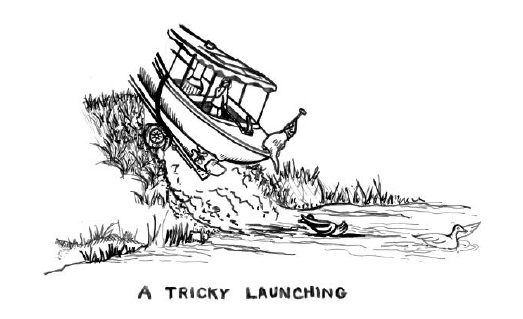
Impressed by this display of English foolhardiness, the captain gave every further assistance, including stowing the car and trailer in his yard for a couple of weeks.
Although it was spring, the weather was not all that one might expect of the south of France-in fact it rained ‘chats et chiens’ for about a week, causing considerable flooding of the locality. Apart from turgidly, the canal proper was not affected, but we heard that where the canal crossed the River Hérault at Agde, the canal was closed. Just before AgdeThe tiny ‘Libron’ also crosses the canal: normally a ditch it becomes a raging torrent in spate and a Napoleonic ‘flood lock’ is brought into play to allow it to cross the canal at its higher level. To our dismay this was closed as we approached Agde and I feared unreasonable delays, but a conversation with the ‘army’ of lock-keepers that had been sent to operate this amazing device gave us hope-again ahead of an impending peniche-of being ‘locked through’. It was a unique opportunity to witness and assist with its very rare operation.
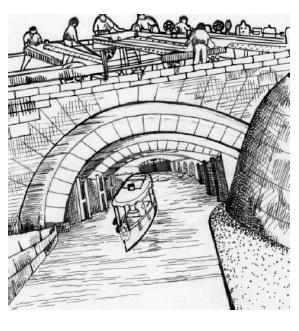
Just before the locks the Libron bifurcates into two streams and rejoins just after. When needs press, the stream is allowed to pass across the canal through channels formed by sets of sliding gates, suspended on rails above, forming two sealed channels with a space of some 200m of canal between.
To pass through when in operation, first one of the two streams is dammed off with sluice gates, the sliding gates opened, with ‘inch bars’on the rails above, boats pass into the lock space and the gates are inched shut behind. The same is repeated with the front channel to allow the boats out.

The amount of clanking, grunting and expletives employed in this event have to be seen and translated to be believed!

This ‘wonder’ was matched for eye popping only by the inclined plane at Beziers. A staircase of nine locks has, not unlike Foxton near home, an inclined plane or water chute alongside. Unlike the Foxton plane, this has a smooth-sided channel running from the lower point to the top level, with a great ‘machine’ which runs up it on rubber tyres, straddling the channel. Boats pass under the machine at the lower end, it lowers a great paddle into the channel behind the boats and then grinds its way uphill, pushing a wedge of water (1000 tons I calculate) ahead, discharging water, boats and, I suspect, a few fish, into the top level. Sadly, like Foxton, it wasn’t working so we had to take the ‘conventional’ locks down.

The only reported account of its operation is an occasion when it was descending with three or four boats, the brakes failed, the emergency brake failed, the operator, deigning not to be associated with the impending disaster, leapt off.
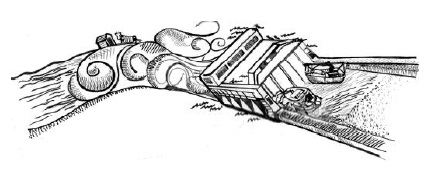
The device reached 25km/hr; the innocent boater thought it a wonderfully speedy alternative to locks until it hit the bottom pound. The boats did not suffer much, but the surrounding area did with the ensuing huge wave!
After a couple of pleasant days spent holed up in Agde, we eventually were allowed to cross the still angry Hérault and entered the Étang de Thau, a sea lake 15 miles x 3 miles wide, crammed with oyster baskets and fishermen in 200hp punts. Although not above a force 4, the trip was quite adventurous enough in a 21 ft river boat and it took days to remove the salt stains from the brass work.
 Mèze before the Étang de Thau
Mèze before the Étang de Thau
Stopping at a couple of lakeside fishing villages, we reached Sète- the official terminus of the Canal du Midi. From there we entered the Canal de Sète et Rhône, not without an enforced overnight stop alongside the rather inhospitable railway wharf due to the wind upping to a 6 and the waves being considerably higher than our spirits in the early evening.
This last leg enters the Camargue, and although whilst true legend white horses and flamingos abound, the only black bull I saw was on my plate in a local Auberge!
The canal passes within half a mile of the Mediterranean coast and a number of fishing towns in this area have their own cut from the harbour to the canal.
One such town, Palavas-Les-Flots, advertised at its entrance a sadly all too rare a commodity on this waterways-showers!
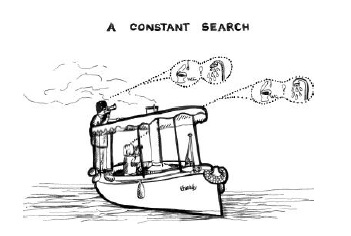
On all of our previous French waterways cruises we had found excellent waterside facilities by way of showers and toilets at many locks- but not so, on the Midi. Although we did manage to somehow meet our daily needs, it did require some ingenuity, and required that one showered and toileted at any hour of day or night, when the opportunity arose.
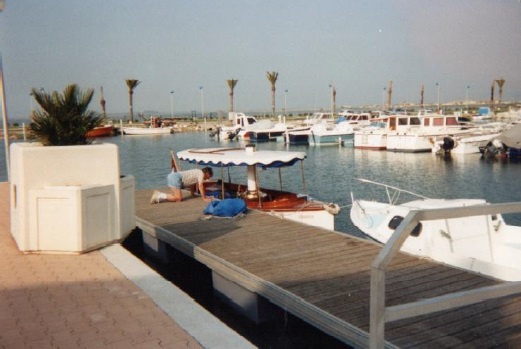
We found ourselves lathering up in such places as a football stadium, un-let hire boats, ‘Douches à la Chantilly’, and occasionally, to our delight, in a marina.
So this opportunity had to be taken. When we entered the town’s new marina, we were immediately ‘adopted’ by the Captain of the port, François, who gave us the prime berth-right outside the loo’s and offered us the freedom of the port. Within minutes, a small crowd of his boaty friends had gathered around, including a local reporter for the ‘Midi Libre’ who was also a member of the local old boats club.
After giving a few trips around the harbour, and steaming briefly out into the Med, we were invited as guests of honour to a specially convened dinner by the old boats club, ‘Les Vieux Grémants’.
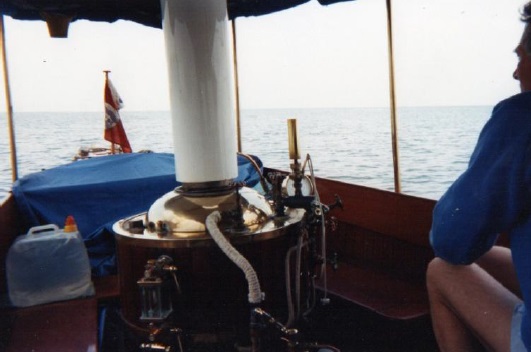 On the Med!
On the Med!
A convivial evening of good food, plentiful wine and probably misunderstood anecdotes followed, by which time the Commodore declared that they would be delighted to entertain any SBA or TVSC members similarly-but please would we not all come at once!
Steaming continued well into the night with Chantilly taking the last of the party back to the marina at around 1am.
Next morning, before breakfast was finished, visitors arrived once more, this time bringing gifts of wine, food, books, etc. More trips followed and we eventually left many new friends, a little sadly, amidst multiple whistle blasts and promises to return.
It seemed like only a few shovels of coal before our journeying was completed at Beaucaire, then en train to Carcassonne to fetch the car and trailer for our return home.
Our trip took us some 300 km with about 50 locks, we consumed 200 kg of coal (after coaling difficulties on our previous trips we took it all with us!) which computed to around 20 kg for each steaming day of 10-12 hours. We had no real mechanical problems, and to illustrate that we missed nothing, we arrived back home with only 5 kg of coal and five francs!